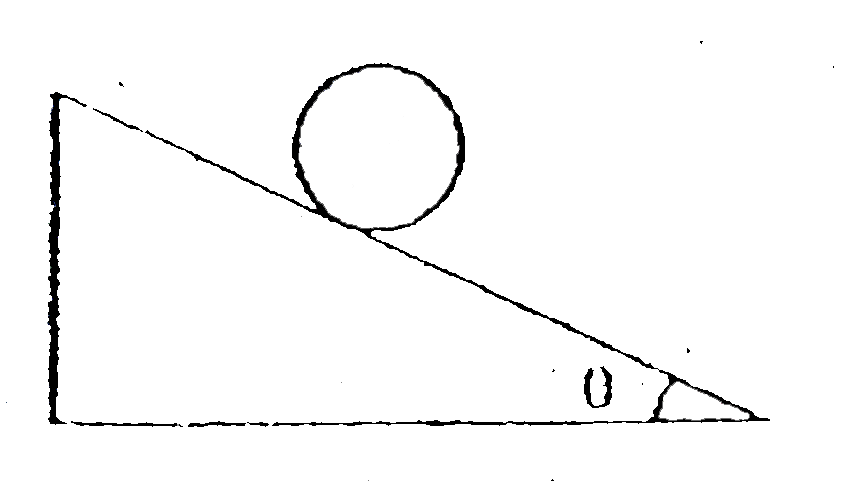A solid sphere is rolling down an inclined plane without slipping of height 20 m. Calculate the maximum velocity with which it will reach the bottom of the plane
To solve the problem of a solid sphere rolling down an inclined plane without slipping from a height of 20 m, we can use the principle of conservation of energy. Here's a step-by-step solution:
Step 1: Understand the Energy Conservation Principle
At the top of the incline, the sphere has gravitational potential energy and no kinetic energy (since it starts from rest). As it rolls down, this potential energy is converted into kinetic energy (both translational and rotational).
Step 2: Write the Expression for Potential Energy
The potential energy (PE) at the height h is given by:
PE=mgh
where:
- m is the mass of the sphere,
- g is the acceleration due to gravity (10 m/s²),
- h is the height (20 m).
Step 3: Write the Expression for Kinetic Energy
The kinetic energy (KE) at the bottom consists of translational kinetic energy and rotational kinetic energy:
KE=12Iω2+12mv2cm
where:
- I is the moment of inertia of the solid sphere about its center of mass, given by I=25mr2,
- ω is the angular velocity,
- vcm is the translational velocity of the center of mass.
Step 4: Relate Angular and Translational Velocity
For a rolling object without slipping, the relationship between angular velocity ω and translational velocity vcm is:
vcm=rω
Thus, we can express ω in terms of vcm:
ω=vcmr
Step 5: Substitute I and ω into the KE Equation
Substituting I and ω into the kinetic energy equation gives:
KE=12(25mr2)(vcmr)2+12mv2cm
This simplifies to:
KE=15mv2cm+12mv2cm=(15+12)mv2cm
Step 6: Combine and Solve for vcm
Setting the initial potential energy equal to the final kinetic energy:
mgh=(15+12)mv2cm
Cancelling m from both sides:
gh=(15+12)v2cm
Calculating 15+12=210+510=710:
gh=710v2cm
Step 7: Solve for vcm
Rearranging gives:
v2cm=10gh7
Taking the square root:
vcm=√10gh7
Step 8: Substitute Values
Substituting g=10m/s2 and h=20m:
vcm=√10×10×207=√20007≈√285.71≈16.9m/s
Final Answer
The maximum velocity with which the solid sphere will reach the bottom of the plane is approximately 16.9m/s.
---
At the top of the incline, the sphere has gravitational potential energy and no kinetic energy (since it starts from rest). As it rolls down, this potential energy is converted into kinetic energy (both translational and rotational).
The potential energy (PE) at the height h is given by:
PE=mgh
where:
- m is the mass of the sphere,
- g is the acceleration due to gravity (10 m/s²),
- h is the height (20 m).
The kinetic energy (KE) at the bottom consists of translational kinetic energy and rotational kinetic energy:
KE=12Iω2+12mv2cm
where:
- I is the moment of inertia of the solid sphere about its center of mass, given by I=25mr2,
- ω is the angular velocity,
- vcm is the translational velocity of the center of mass.
For a rolling object without slipping, the relationship between angular velocity ω and translational velocity vcm is:
vcm=rω
Thus, we can express ω in terms of vcm:
ω=vcmr
Substituting I and ω into the kinetic energy equation gives:
KE=12(25mr2)(vcmr)2+12mv2cm
This simplifies to:
KE=15mv2cm+12mv2cm=(15+12)mv2cm
Setting the initial potential energy equal to the final kinetic energy:
mgh=(15+12)mv2cm
Cancelling m from both sides:
gh=(15+12)v2cm
gh=710v2cm
Rearranging gives:
v2cm=10gh7
Taking the square root:
vcm=√10gh7
Substituting g=10m/s2 and h=20m:
vcm=√10×10×207=√20007≈√285.71≈16.9m/s
The maximum velocity with which the solid sphere will reach the bottom of the plane is approximately 16.9m/s.
Topper's Solved these Questions
- ROTATIONBook:DC PANDEY ENGLISHChapter:ROTATIONExercise:Check point 9.1
Explore 20 Videos
- ROTATIONBook:DC PANDEY ENGLISHChapter:ROTATIONExercise:Check point 9.2
Explore 20 Videos
- RAY OPTICSBook:DC PANDEY ENGLISHChapter:RAY OPTICSExercise:Integer type q.
Explore 14 Videos
- ROTATIONAL MECHANICSBook:DC PANDEY ENGLISHChapter:ROTATIONAL MECHANICSExercise:Subjective Questions
Explore 2 Videos
Similar Questions
Knowledge Check
A solid cylinder of mass M and radius R rolls down an inclined plane without slipping. THE speed of its centre of mass when it reaches the bottom is
A√(2gh)B√4/3.ghC√3/4.ghD√(4g/h)
A solid cylinder of mass M and radius R rolls down an inclined plane of height h. The angular velocity of the cylinder when it reaches the bottom of the plane will be :
View SolutionA uniform ring rolls down an inclined plane without slipping. If it reaches the bottom of a speed of 2m/s, then calculate the height of the inclined plane (use g=10m/s2)
View SolutionA uniform ring rolls down an inclined plane without slipping. If it reaches the bottom of a speed of 2m/s, then calculate the height of the inclined plane (use g=10m/s2)
View SolutionA uniform solid spherical ball is rolling down a smooth inclined plane from a height h. The velocity attained by the ball when it reaches the bottom of the inclined plane is v. If ball when it reaches the bottom of the inclined plane is v. If the ball is now thrown vertically upwards with the same velocity v, the maximum height to which the ball will rise is
View SolutionA solid cylinder of mass M and radius R rolls down an inclined plane of height h without slipping. The speed of its centre when it reaches the bottom is.
View SolutionThe velocity of a sphere rolling down an inclined plane of height h at an inclination θ with the horizontal, will be :
View SolutionA ring starts to roll down the inclined plane of height h without slipping . The velocity when it reaches the ground is
View Solution

